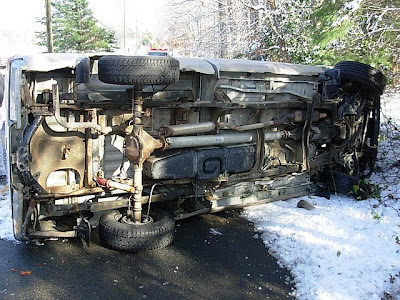 by Marjorie S., Cars for Keeps Social Media Manager
by Marjorie S., Cars for Keeps Social Media ManagerWe've promoted. We've suggested. We've blogged, tweeted and status updated. We've offered coupons. We've done everything we possibly can to impress the importance of proper winter snow tires on our customers, and you've listened - most of you, that is.
Having been in the auto repair industry for as long as we have, we know that some people are just not going to follow our advice, no matter what we do. Maybe you don't believe you actually NEED snow tires, or maybe you just don't have the money for snow tires in your budget right now. Whatever your reasons for not getting those snow tires installed, this post is for you!
Keep in mind the recommendations below are NOT an encouragement to keep your vehicle unprepared for winter weather. Still, we understand that sometimes "life happens". If you're driving on bald tires for one reason or the other, we at least want you to have the driving knowledge to take what Michigan winters will throw at you.
Winter Driving on Bald Tires
So you're driving on summer tires, bald tires, or perhaps all weather tires. If your vehicle is "compact", it's much more susceptible to skidding around on the ice and getting blown off course by semi trucks. What can you do to drive safely in these conditions?
Slow. Down. It's painfully basic, but it's true. The faster your bald-tired little vehicle goes on slippery snow and ice, the less traction it has. If your car is not equipped for winter, leave yourself more time to get places and drive slowly during inclement road conditions. Sure, it's inconvenient, but it could save your life.
Use lower gears. This especially applies to driving up or down inclines on icy roads; using lower gears can help to give you more traction and maintain a slower, steadier speed.
Never forget road conditions. If you're driving on bald tires during an ice storm, you're probably not going to think about anything else until you've taken the key out of the ignition. If you're driving on old all-weather tires in slushy barely freezing weather, however, you might be tempted to become overconfident and forget about your car's treacherous position. The moment you take your vehicle's traction for granted and brake or steer too hard is the moment you might lose control of the vehicle.
Maintain space between your car and other vehicles. Who cares if you're driving like dear old grandma? Maintaining extra space between the cars around you is an easy way to avoid costly fender benders in town. On the freeway, it's an easy way to avoid a fatal crash.
Don't rely on your brakes. When you're driving on bad tires in bad conditions, avoid the temptation to over-brake at all costs. If your vehicle has little or no traction, braking hard is more likely to cause your car to spin out of control than anything else. At high speeds on the freeway, even braking lightly on ice can cause your brakes to lock and your vehicle to lose control. In these situations, the best way to slow down is to remove your foot from the gas, wait for some deceleration (if you can), then pump the brake pedal slowly and firmly. If you don't have ABS, this can also prevent your wheels from locking.
 Drive behind salt trucks. Passing heavy equipment during inclement weather is treacherous in a vehicle equipped with great snow tires. If you're driving a poorly equipped car, do yourself a favor and remain behind salt trucks as long as you can. Sure, you'll probably get where you're going late, and your car will definitely need an undercarriage wash, but you'll avoid a potentially bad accident.
Drive behind salt trucks. Passing heavy equipment during inclement weather is treacherous in a vehicle equipped with great snow tires. If you're driving a poorly equipped car, do yourself a favor and remain behind salt trucks as long as you can. Sure, you'll probably get where you're going late, and your car will definitely need an undercarriage wash, but you'll avoid a potentially bad accident.If your vehicle is medium to heavy duty truck with rear or four wheel drive, toss heavy items such as bricks or old summer tires in the back. Even if your tires are bald, the extra weight should help to give you a little much-needed traction.
Safe driving! (and remember: it's not too late to get snow tires installed...)



